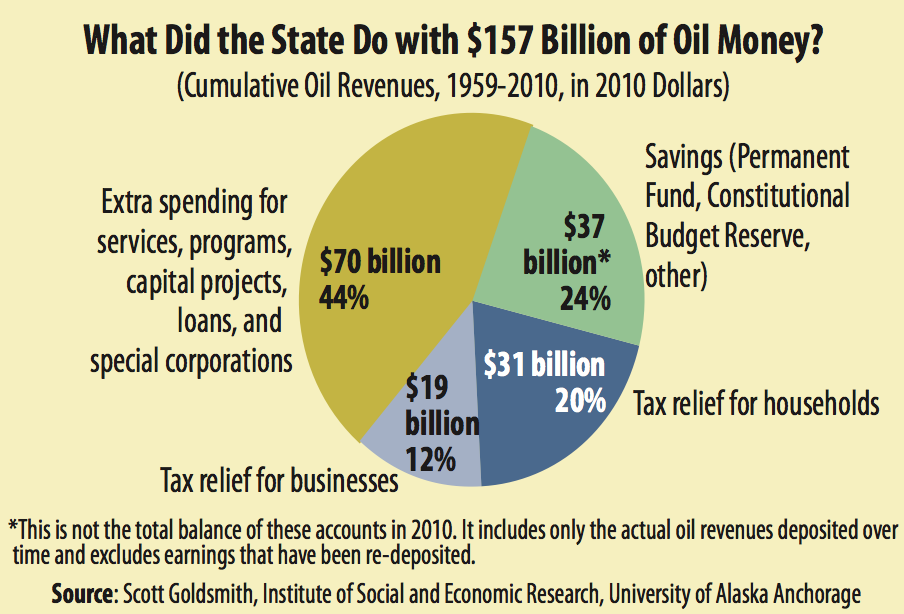Imagine if the Trans-Alaska Pipeline System (TAPS) prematurely shuts down due to the steepening decline in North Slope production, which has far surpassed state forecasts. A new report by the Institute of Social and Economic Research (ISER) sheds some light on what Alaska’s economy would look like without TAPS.
If oil had never been discovered on the North Slope, Alaska’s economy today would be about half as big and so would its current workforce, according to ISER.
“To keep the economy healthy as time goes on, Alaska needs new oil production,” said Scott Goldsmith, a professor of economics at ISER. “Nothing else, including North Slope natural gas, can replace oil in the state’s economy.”
The well-known University of Alaska Anchorage economist pointed out that oil wealth has had huge “spinoff” effects on Alaska – broad economic effects that benefit virtually every household, community and business in the state. “Those spinoffs include an economy and population that are twice the size they’d otherwise be, and the highest per capita public spending in the country, coupled with the lower state taxes on households and many types of businesses,” Goldsmith said.
Spinoffs of oil wealth have helped non-oil sectors of the economy prosper and create about 60,000 more jobs than they otherwise could have, according to ISER. The jobs are in addition to the 127,000 jobs generated by oil production and state spending of its oil revenues. Together, all the jobs that can be traced in some way to oil development make up half of all jobs in Alaska.
Goldsmith noted an Alaskan family of four enjoyed an estimated value of $22,000 from oil industry activity in 2010, including tax relief, Permanent Fund dividends, and enhanced public services. Communities, industries and local businesses enjoy tax relief, too, as well as lower costs, economics of scale, better infrastructure, enhanced opportunities, and improved quality of life, Goldsmith pointed out.
“Other sectors will be important for Alaska’s future growth, but oil will remain the state’s main economic driver, so Alaska needs to develop a strategy that will provide the greatest long-term benefits from future oil production for the state, the economy, and Alaskans,” Goldsmith said. “New oil production is critical for the health of the economy and Alaskans need to understand that.”
Goldsmith warned Alaskans to not assume high oil prices will shield the state from the effects of declining production. He said production is a third of what it was, and is declining steadily.
So far Alaska has produced 17 billion barrels of oil, which make up 80 percent of the value of all Alaska resource production since 1959, but 98 percent of the $161 billion in resource revenues the state government has collected. Of the $157 billion in revenues (adjusted for inflation) the state government has received so far from oil, 44 percent or $70 billion has been spent for services, programs, capital projects, loans, and special corporations. Twenty-four percent or $37 billion went to savings and the Permanent Fund, 20 percent or $31 billion was used for tax relief for households, and 12 percent or $19 billion was spent on tax relief for businesses.
Oil and the future
There is a lot of oil on the North Slope and offshore. In the near term, production will come mainly from producing fields, which may have about 5 billion barrels of conventional oil remaining. In addition, there could be up to 2 billion barrels of oil on state lands that have yet to be explored. The North Slope also has billions of barrels of viscous and heavy oil, which is thick and expensive to produce, but very little is currently economic to develop. Beyond state lands, federal areas are currently estimated to contain 33 billion barrels of technically recoverable oil, in both onshore and offshore areas.
How much of the state and federal oil is actually produced will depend on geology, economics, technology, politics, and Alaska’s success in attracting the industry investment needed to develop these prospects.
Without oil, Goldsmith said Alaska’s economy would likely be very seasonal, with the exception of mining.
Meanwhile, Alaska’s population is now triple what it was in 1960, up from 226,000 to 710,000 in 2010. Alaska can only support a population that large because oil and its associated revenues have generated so many jobs.

Return to newsletter headlines